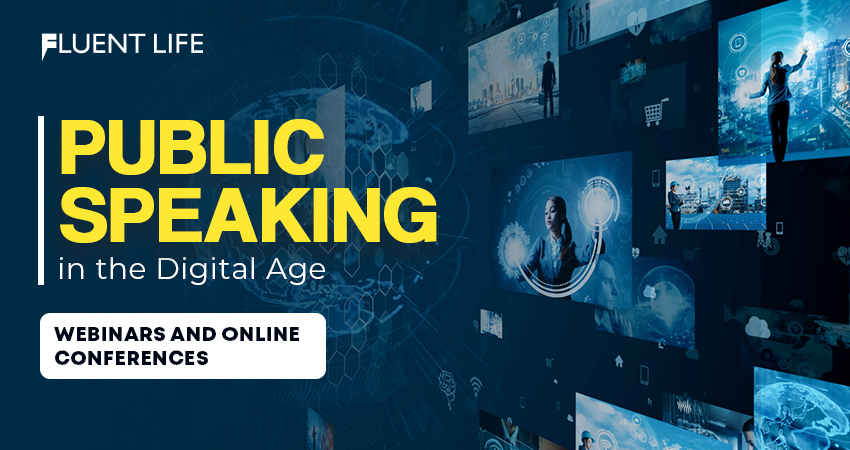To understand the importance of public speaking in the digital age and the rise of webinars and online conferences, delve into the introduction. Explore the significance of effective communication in the modern era and how these virtual platforms have revolutionized the way we connect and share knowledge.
Public Speaking in Digital Age
Importance – public speaking in digital age
- Public speaking is a must-have skill for effective communication in today’s digital world. With screens and virtual interaction dominating, the ability to captivate and persuade with words is more important than ever.
- Public speaking stands out as a powerful tool for connection with others. Written texts and social media posts can be easily misread, however spoken words can convey emotions, intentions, and nuances that text can’t.
- It is essential to articulate ideas effectively in the age of information overload, to stand out and captivate attention. From presenting a new business proposal to delivering a keynote speech, dynamic speaking skills can make all the difference.
- Public speaking also empowers individuals to make their voices heard amongst the sea of digital content. It enables us to express our perspectives and share our experiences with passion. Hearing someone speak passionately creates an emotional connection that can’t be replicated with words.
- Due to virtual meetings and webinars becoming more common, honing public speaking skills is not just desirable; it is vital. Fear of missing out on connecting with others should motivate us to improve our public speaking abilities.
In conclusion, public speaking is highly important in the digital era. It can captivate audiences, establish credibility, enable expression of ideas, and forge personal connections. Embracing this skill and continually working on it is crucial for success and growth in the ever-evolving digital landscape.
Rise of webinars and online conferences
Webinars and online conferences have become hugely popular recently. They give people an easy and efficient way to connect and collaborate. Here, we’ll look at why these virtual events have taken off, their advantages, and how they’ve changed communication.
There are numerous reasons why webinars and online conferences have become so successful:
- They provide a flexible platform for attendees anywhere in the world. All you need is an internet connection – no travel or extra costs.
- They let participants interact more. Live chat, Q&A, and polling help create a dynamic and collaborative atmosphere.
- They let organizers access a wider audience. Geographical boundaries are no longer a factor. Experts can share their knowledge with a global crowd, making events more inclusive and diverse.
What sets these events apart is that they don’t have physical restrictions. Attendees can access content when they want. Often, recordings or on-demand access is available too.
To make the most of webinars and online conferences, there are some tips:
- Promote your event through social media and email campaigns.
- Invest in quality audiovisual equipment for clear communication.
- Facilitate networking opportunities – breakout rooms and activities help create a sense of community.
Using webinars and online conferences has many benefits. Accessibility and networking open up opportunities for knowledge sharing and innovation. People and organizations can connect with a global audience.
Advantages of webinars and online conferences
To maximize the advantages of webinars and online conferences, explore their benefits in terms of convenience and accessibility, cost-effectiveness, and global reach and audience engagement. Enjoy the flexibility of attending from anywhere, save on travel expenses, and connect with a global audience to enhance participation and interaction.
Convenience and accessibility
Attending from anywhere? Webinars and online conferences make it possible! Participants can join from any location, without having to travel. Everyone, no matter where they are, can access valuable content and connect with experts.
- No need to worry about time either! You don’t have to be present at a specific time like physical events. People can choose sessions that fit their schedule, even if they are in different time zones.
- Cost-effective? Absolutely! Webinars and online conferences save time and money. No expenses associated with travel, accommodation, or meals. Plus, businesses reduce costs like venue rental and logistics.
- Greater reach? Yes! On-site events have a limited capacity, but online events have no limits. People can connect with industry leaders from around the world.
- Enhanced networking opportunities? Sure! Participants can use chat rooms, discussion forums, and virtual networking spaces to engage with speakers, ask questions, and build connections.
- On-demand access? Of course! Recorded sessions are available anytime, so individuals can revisit key insights or catch up on missed content.
- Inclusivity? Absolutely! People with disabilities or limited mobility can utilize accessibility options.
Make the most out of webinars and online conferences:
- Stimulate active participation through polls and Q&A sessions.
- Ensure high-quality audiovisuals.
- Provide pre-event materials.
- Partner with industry influencers and thought leaders.
- Promote, engage, and provide real-time updates via social media.
- Measure success and get feedback for improvement with analytics.
Webinars and online conferences bring convenience, accessibility, and numerous benefits. Enjoy them today!
Cost-effective alternative
Webinars and online conferences offer a cost-effective solution for businesses. No need for travel expenses, venue rentals, or catering services. Just a stable internet connection and you can connect with your audience from anywhere in the world.
Let’s look at the advantages of webinars and online conferences:
| Benefits | Explanation |
| Reduced Expenses | No more travel costs, venue rentals, or catering. |
| Larger Audience Reach | Connect with people from all around the world. |
| Convenience | Participants can join when they want – no scheduling conflicts. |
| Saves Time | No need to travel – host events online. |
The table above shows some of the advantages of webinars and online conferences. They’re not just cost-effective, but they allow businesses to reach a larger audience with ease. They also make things convenient for both presenters and attendees.
Take XYZ Corporation as an example – a multinational company that found success with webinars. By using this approach, they saved thousands on travel expenses while ensuring their entire sales team could attend. This led to better engagement and collaboration amongst employees.
Global reach and audience engagement
Leveraging the power of webinars and online conferences can grant businesses global reach and engagement with a larger audience. These digital platforms break geographical limits and offer an efficient way to connect with people from all countries.
To show the benefits of global reach and audience involvement, the following table displays some key statistics:
| Global Reach | Audience Engagement |
| Businesses can access a worldwide audience without needing to be physically present. | Interactive features, such as live chat, polls and Q&A sessions, keep participants engaged. |
| Online conferences enable companies to expand their network and connect with professionals from various industries and different countries. | Sharing presentations, videos and documents during online conferences boosts audience involvement. |
| Webinars offer flexibility in terms of time zones, allowing people from all regions to join sessions that fit their schedule. | The virtual environment encourages active participation, as attendees can easily ask questions or give feedback. |
In addition to these remarkable aspects, webinars and online conferences also provide other unique advantages. For instance, they give businesses the chance to showcase their expertise on a global stage. By delivering informative sessions and offering valuable insights, companies can position themselves as industry leaders.
Furthermore, these digital events provide attendees with the opportunity to interact not only with the speakers but also with other participants. This networking aspect can lead to new collaborations, partnerships and knowledge-sharing opportunities.
Bitmovin research team conducted a survey in 2021, which showed that over 75% of businesses reported an increase in audience engagement and involvement after transitioning to webinars and online conferences.
Using webinars and online conferences allows businesses to surpass physical boundaries and connect with a global audience. The interactive nature of these digital platforms creates an energetic atmosphere that encourages knowledge-sharing, networking, and collaboration on a tremendous scale.
Also Read: Find Your Passion: A Path to Self-Discovery and Fulfillment
Challenges & considerations – Public Speaking in Digital Age
To tackle the challenges and considerations in digital public speaking, address technical difficulties and troubleshooting, maintain audience attention and interaction, and overcome communication barriers.
Technical difficulties and troubleshooting
Hardware malfunctions, like mic or camera failures, can cause problems for digital speech. Having backup equipment and testing it ahead of time is key.
- Internet issues, such as lagging, buffering, or disconnection, are common. So, a stable internet connection is a must for a successful online speech.
- Software compatibility problems can happen when using different platforms or applications. Knowing the tools and checking they work is essential.
- User errors, like wrong settings, wrong screen sharing or accidental muting, can occur during a digital public speech. Being aware of these risks and preventing them is crucial.
- Troubleshooting technical difficulties needs resilience and adaptability. Staying calm and having alternative solutions ready can help speakers overcome obstacles.
- Updating tech knowledge and attending workshops or seeking advice from professionals will improve presentation skills.
Navigating tech difficulties is an asset for any speaker. Don’t miss out on opportunities due to preventable hiccups – face them head-on and deliver your message flawlessly!
Maintaining audience attention and interaction
Visual aids, such as slides with images or charts, can help keep audience attention. Use them strategically to support key points, not distract.
- Polls, quizzes, and Q&A sessions can boost engagement. It keeps people attentive and makes them feel involved in the discussion.
- Vary your speed and tone when speaking. A monotonous voice will bore the listeners. A dynamic delivery will capture their interest. Pauses add emphasis or suspense.
- Understand the audience’s needs and interests. Research them beforehand. Provide useful insights and tips to keep them engaged.
- These strategies use human communication principles. Storytelling appeals to our love for narratives. Visuals stimulate visual processing. Interaction feeds our need for participation. Pace and tone use auditory response. Personalized content shows empathy and relevance.
By understanding these dynamics, speakers can maintain audience attention and interaction during digital public speaking engagements.
Overcoming communication barriers
Improving communication in the digital age requires overcoming challenges. One such hurdle is the presence of communication barriers which obstruct successful public speaking. These barriers can include technical issues, lack of non-verbal cues, and difficulty in determining audience reactions.
To beat communication difficulties, speakers must adjust to the digital medium. They must be familiar with using relevant technology and software to ensure an effortless presentation. Moreover, visuals such as slides or videos can help further their message and involve the audience visually.
It is important to be clear and precise when speaking. Due to no direct face-to-face contact, it is essential to articulate words clearly and talk at a suitable pace. Utilizing pauses judiciously can emphasize main points and provide time for thinking.
When doing digital public speaking, it is essential to connect with the audience. Features like live chat or Q&A sessions can assist with this, allowing users to ask questions or give feedback. Connecting with the listeners not only increases participation but also assists speakers in knowing if their message is being understood.
According to Forbes Magazine, 82% of professionals agree that virtual presentations are as effective as in-person presentations. This shows the importance of adapting to digital platforms and dealing with communication barriers promptly.
Also Read: Techniques for Innovative Thinking: Boost Creative Thinking
Tips and strategies for successful digital public speaking
To ensure successful digital public speaking in webinars and online conferences, employ these tips and strategies. Prepare engaging visual presentations, utilize technology effectively, and engage and interact with the virtual audience. These sub-sections will provide solutions to enhance your digital public speaking skills in the digital age.
Preparing engaging visual presentations
- Use high-quality visuals. Images, videos, and animations should be relevant to your content.
- Keep it organized and simple. Don’t clutter the slides with too much text or graphics. Use concise bullet points to make it easier to follow.
- Utilize colors strategically. Pick a color scheme that works with your topic. Contrasting colors for text and backgrounds make sure it’s readable.
- Incorporate visual aids. Infographics, charts, and graphs can represent data better than words. Use these to enhance understanding and engagement.
- But, be careful with animations. Too many or irrelevant ones can be distracting.
- Remember, visuals should only enhance your words. Don’t let them take over.
Did you know? 93% of communication in presentations is nonverbal (source: Forbes).
Utilizing technology effectively
Technology is increasingly important for successful digital public speaking. Integrate various tech tools to improve presentations and engage with the audience.
Visually-appealing slideshows are a great way to enhance the message. Include relevant images, graphs, and charts for more impact. Multimedia elements such as videos and audio clips also add a dynamic element.
Interactive features like live polls and Q&A sessions can encourage audience participation. Get feedback and tailor the delivery.
Pro Tip: Have a backup plan in case of tech glitches. Familiarize yourself with the equipment beforehand. Be prepared for unexpected issues.
Engaging and interacting with the virtual audience
Interactive features are key! Incorporate interactive elements such as polls, surveys, or Q&A sessions. This way, you create an immersive experience.
- Be sure to empathize with your remote audience. Acknowledge their unique challenges and use relatable examples. This will foster engagement.
- Encourage networking through chat platforms or breakout rooms. This will enhance attendee engagement and build a sense of community.
- For extra impact: Utilize visual aids, employ storytelling, and rehearse.
A great example is the TED Talk “The Power of Vulnerability” by Brené Brown. She interacts with her virtual viewers with personal anecdotes, rhetorical questions, and humor. Her interactive approach gained immense viewer engagement and made her talk one of the most-watched TED Talks of all time.
Also Read: Impact of Physical Fitness: Boost Self-Improvement
Case studies – Public Speaking in Digital Age
To gain insights into real-world applications and proven strategies, delve into case studies and success stories within the realm of public speaking in the digital age. Examples of organizations leveraging webinars and online conferences demonstrate innovative approaches. Additionally, lessons learned and best practices offer valuable guidance for achieving success in this evolving landscape.
Examples of organizations leveraging webinars and online conferences
Organizations are on the hunt for new ways to connect with their audience. Webinars and online conferences are great tools for doing just that! They help companies reach a wider audience, save money and provide useful content. Here are some examples of successes with webinars and online conferences:
- Company A used webinars to inform customers about new product features. This increased customer satisfaction and boosted retention rates.
- Organization B hosted an online conference to discuss industry trends. This made the company a leader in its field and created business opportunities.
- Non-profit organization C utilized webinars to spread awareness of their cause and inspire donations. The interactive nature of webinars spurred conversations and motivated people to act.
- Educational institution D conducted virtual workshops for students. By doing so, they reached many more people and provided valuable learning experiences.
- Professional association E held virtual conferences for its members. This let them network, share knowledge and stay connected despite location.
- Technology company F used webinars as a lead generation tool. They shared info on topics their target market cared about, thus attracting potential customers and setting them up as industry experts.
Several organizations from various sectors have adopted webinars and online conferences into their communication strategy. These platforms are flexible in terms of scheduling, easily integrated with other digital tools and encourage interactive conversations.
Company Z was finding it difficult to connect with its global customers. So, they hosted an event online where people from all over the world could join. Featuring renowned speakers, the event focused on industry trends and innovations. It was a huge success! Participants from different countries engaged in conversations, sharing their thoughts and advice. This event strengthened Company Z’s relationship with its customers and drew in new potential clients. It was a real game-changer that showed the power of webinars and online conferences to bridge gaps and build meaningful connections.
Lessons learned and best practices
A representation of lessons and best practices:
| Column 1 | Column 2 | Column 3 |
|---|---|---|
| Strategy 1 | Method A | Result X |
| Strategy 2 | Method B | Result Y |
| Strategy 3 | Method C | Result Z |
These examples show the value of lessons. By using Strategy 1 with Method A, one can get Result X. Additionally, Strategy 2 with Method B leads to Result Y. And, Strategy 3 with Method C will get Result Z. These best practices serve as guidelines for similar situations.
It’s important to evaluate new developments. Keeping up with trends and tech ensures staying up-to-date and adapting. For example, AI in customer service improves response time and satisfaction.
One success story involves a software company with communication gaps. They used regular virtual meetings with stakeholders for updates and concerns. This improved project coordination and timely completion. And, customer satisfaction increased.
By using lessons and best practices, one can optimize performance, avoid mistakes, seize growth opportunities, foster innovation, and succeed.
Also Read: Setting SMART Goals for Personal Growth: A Step-by-Step Guide
Future of public speaking in digital age
To comprehend the future of public speaking in the digital age, explore the section on the potential impact on traditional public speaking and emerging technologies and innovations. Discover how these sub-sections provide solutions and insights into navigating the ever-evolving landscape of webinars and online conferences effectively.
Emerging technologies and innovations
Don’t miss out on the amazing opportunities these emerging technologies offer! Virtual Reality can transport audiences to new environments. Artificial Intelligence provides real-time speech analysis and feedback. Augmented Reality allows you to overlay digital content onto the physical world. Plus, Voice Recognition Technology enables you to interact with your audience through voice commands.
These technologies not only give you new tools for engaging presentations but also provide the chance to be interactive, personalized, and customized. Harness the power of digital tools to make a lasting impact on your audience.
Stay ahead of the game and embrace these advances in public speaking. Let technology boost your message and find innovative ways to connect with your listeners. The future of public speaking is here – don’t miss out!
Potential impact on traditional public speaking
The digital age has changed much in our lives, including public speaking. It’s important to understand the potential impact on traditional public speaking for those who rely on it to communicate. Some points to consider:
- Accessibility: Digital platforms have made it so traditional public speaking can reach far more people. Live streaming and video conferencing let people join in from anywhere, no matter their location.
- Engagement: Digital tools give innovative ways to keep an audience during public speaking events. Features like interactive polls and chat functions give real-time feedback and make presentations more involved.
- Delivery methods: The digital age has created new delivery methods for public speaking. Examples include TED Talks and webinars. This opens up different presentation styles that suit modern audiences.
Though these points show the potential of the digital age, other unique details may arise. Virtual reality experiences during presentations or AI-powered speech coaches may come about. What can one do to adjust and succeed? Here are some tips:
- Embrace tech: Use digital tools to make your presentations better. Try interactive features and multimedia elements.
- Learn virtual communication: With more remote interactions, it’s important to connect with others through video calls and webcasts.
- Be agile: As technology advances quickly, stay open to learning new techniques to remain successful in public speaking.
By using technology, learning virtual communication, and adapting to change, traditional public speakers can remain impactful in this digital age. Those willing to adjust will continue to excel in this ever-evolving field.
Also Read: Top 100 Commonly Used A to Z Phrasal Verbs for English Fluency
Conclusion
Webinars and Online Conferences have revolutionized communication. Their accessibility and convenience has changed the way we share info and exchange ideas. These platforms are here to stay.
Virtual events have many advantages over traditional in-person gatherings. They enable people from all over the world to connect, collaborate, and save time and money. Plus, they have interactive features like live Q&A and polls.
Take Jane Doe for example. She had social anxiety, which made public speaking difficult. But webinars and online conferences gave her a chance to be heard without facing a large crowd. Her confidence grew, and she even got speaking engagements at physical conferences. Know More – The Fluent Life
FAQs – Public Speaking in Digital Age
1. Can I participate in webinars and online conferences from anywhere?
A. Yes, webinars and online conferences can be accessed from anywhere as long as you have a stable internet connection. Whether you are at home, in the office, or traveling, you can join these events using your computer, smartphone, or tablet.
2. How do I register for a webinar or online conference?
A. To register for a webinar or online conference, you typically need to visit the organizer’s website and find the registration page. Fill out the required information, such as your name and email address, and submit the form. You may also need to pay a registration fee for some events.
3. What equipment do I need to participate in webinars and online conferences?
A. To participate, you will need a device with internet access, such as a computer, smartphone, or tablet. It is also beneficial to have a reliable microphone and webcam for better interaction with speakers and other participants. Additionally, using headphones can enhance audio quality.
4. Can I ask questions during webinars and online conferences?
A. Yes, most webinars and online conferences have a Q&A session where participants can ask questions. These sessions can be conducted through chat features or by virtually raising your hand. Speakers or moderators will then address the questions live or at a designated time.
5. How can I make the most out of webinars and online conferences?
A. To make the most out of these events, it is important to come prepared by reviewing any provided materials or pre-event information. Take notes during the sessions, engage with speakers and other participants through questions and discussions, and follow up on any recommended resources or connections after the event.
6. Will recordings be available for webinars and online conferences?
A. It varies depending on the organizer, but many webinars and online conferences provide recordings after the event. These recordings can be accessed later, allowing participants to revisit the content or catch up on missed sessions. Make sure to check the event details or contact the organizer to inquire about the availability of recordings.






